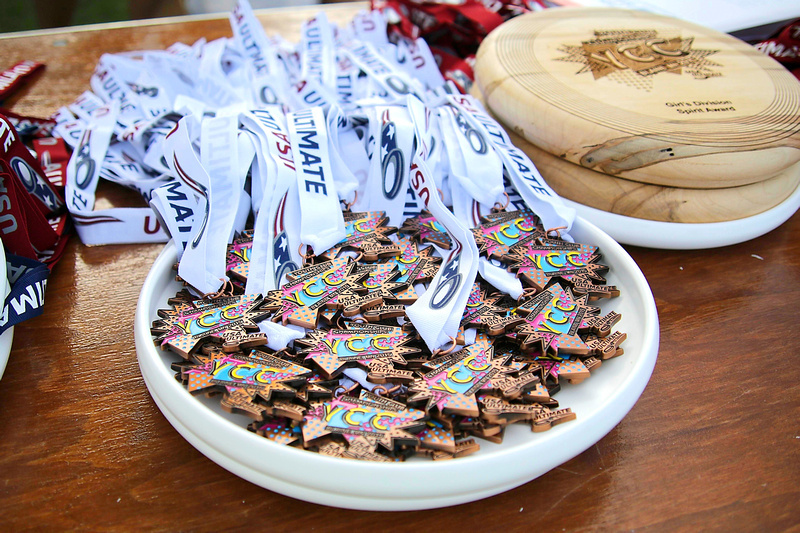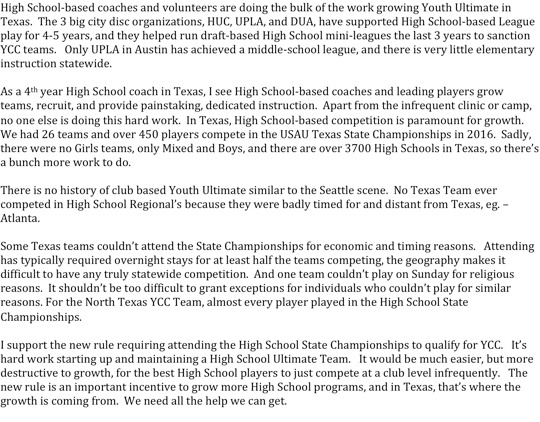[caption id=“attachment_39632” align=“aligncenter” width=“800”]
YCC 2015 Medal Ceremony. Photo: Alex Fraser – UltiPhotos.com[/caption]This week, USA Ultimate announced the 2017 Youth Competition Guidelines, which lay out some significant changes to the structure of youth ultimate.
As announced in March, high school Regionals have been discontinued and replaced by a new regional structure for youth club Regionals (unaffiliated with high schools). But an unexpected eligibility change for the Youth Club Championships has also made waves: “Players must have participated with their high school team in the most recent USAU High School State Championships in order to be eligible [to compete in YCC].”
Although USAU conformed the age eligibility rules (U20 and U17) to match those of the World Flying Disc Federation, for the older cohort ((to be eligible, players may not turn 20 in the year of that YCC)), the new age rules are not likely to matter, as the new HS States requirement will effectively limit competition to those currently in high school. In recent years, many top YCC teams have contained young college players who met the age eligibility requirements.
“The idea is much more targeted at stimulating the growth of state championships within the USA Ultimate structure than it is at individual athletes,” said USAU Director of Marketing and Communications Andy Lee of the primary purpose for the new rule. He added that the second goal is to “restrict the participation of college athletes from the Youth Club Championships, which over time we believe will contribute to the growth and development of youth players and local youth communities.” ((You can see Lee’s full statement at the bottom of this article))
While the rule seems certain to advance those two goals, many online have expressed concerns about possible negative effects, including in states where high school competition is not centered around USAU-sanctioned HS State Championships (e.g. Washington or Vermont) and areas with less developed high school ultimate scenes. USAU does note that “exceptions will be considered on a case-by-case basis.” ((USAU noted on Facebook that the Washington boys’ teams, who completed their competitive season this fall, will be exempt from the new rule in 2017.))
Former USA Ultimate (then Ultimate Players Association) Director of Youth Development Kyle Weisbrod ((also a columnist at Ultiworld)) was sharply critical of the changes on Twitter, arguing that the “new structure isn’t player focused or growth oriented.”
The new rules are set to go into effect beginning with the 2017 Youth Club Championships, which will be held in August in Blaine, MN, alongside the US Open.
Here is the full statement from USA Ultimate’s Andy Lee about the rationale for adding the new HS States eligibility rule:
The guidelines have two different goals. One is to create a stronger connection across our youth programs by more directly connecting the dots between High School State Championships and the Youth Club Championships. Both of these competitive opportunities contribute to the growth of youth membership across the country, which is critical in continuing to support youth programs and development initiatives like coaching education, Learn to Play and GUM, along with YCCs, Regionals, States and National Teams. And while club-based youth competition will continue to develop, high school state championships presently provide the majority of the playing opportunities. It’s very important that as states create, develop and grow those events, they also continue to help build the base that in turn supports all of our youth programming. Ensuring that state championships are a part of the nationally recognized youth structure of USA Ultimate and encouraging the nation’s top programs to be a part of it helps to build that base. So the idea is much more targeted at stimulating the growth of state championships within the USA Ultimate structure than it is at individual athletes (for whom exceptions will likely be granted on a case-by-case basis.)The second goal is to restrict the participation of college athletes from the Youth Club Championships, which over time we believe will contribute to the growth and development of youth players and local youth communities. While college players can raise the level of competition at the YCCs, they are also being provided with a more appropriate competitive structure in our college division. And while college athletes also temporarily bolster the rosters of newer youth teams, the rule creates an incentive (and roster space) for youth ultimate communities to invest in the development of younger, local players, which is an important and strategic long-term goal.
Originally published at: https://ultiworld.com/2016/11/30/ycc-participation-now-requires-attendance-hs-state-championships/


